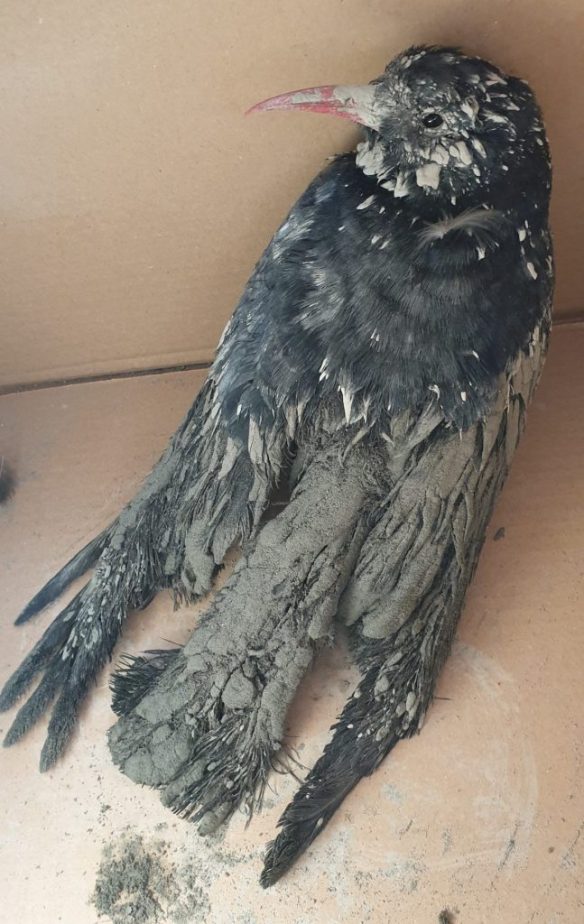Do choughs need a Corvid-19 passport to leave Jersey? Photo by Liz Corry.
Report by Liz Corry
Out of sight but not out of mind
A year ago we had our first-ever confirmed sighting of a chough off-island when a juvenile flew over France. Has it happened again?!
Rocky, a juvenile male from Ronez Quarry, is missing from the flock. He has bright pink and yellow leg rings making it theoretically easy for the team to pick him out in a crowd. He has not been at the supplemental feed. That alone doesn’t mean much these days; however, on one occasion he was the only one not to turn up. This suggests he is either dead or has left the Island effectively reducing the population to 31 choughs.
It would be good if we can start raising our profile across the Channel Islands, Brittany, and Normandy to enable the public to report chough sightings if indeed the birds have flown further afield.
Rocky is not the only one to leave Sorel. Aaron spent a busy weekend transporting sheep off-site to another location for livestock management reasons. I’ve no one to talk to now when I’m cleaning the aviary!
Storm damage
The sheep were still out at Sorel when the storms hit this month. We had a couple of weeks where we were strongly reminded that winter is approaching.
The gales managed to break a food stand, break signposts, dislodge a water butt (it was empty to be fair), and pop several rivets. All easily fixed and looking like new. Or, in the case of signage, actually new thanks to the Government Countryside Rangers.
A few small tears have appeared in the netting and fixing points in need of attention. This will require some extra hands and a sturdy ladder.
The sudden downpours turned walking to the aviary into a game of will I or won’t I end up like a drowned rat? Should I leave the dishes out or condense them down to put under cover? The latter confusing the choughs for a split second when they didn’t find a food dish where it normally would be.
New nest boxes for 2022
We have built two new nest boxes with a grant from the Jersey Ecology Trust Fund. These will replace two existing nest boxes which need to come out for different reasons. Percy and Icho’s box currently requires the hiring of a cherry picker to ring their chicks. The new nest design will allow access from inside the building. Plus, the current one became lopsided back in 2019 and is increasingly at risk of falling down. Not ideal for quarry staff least of all the choughs.
Ronez Quarry will be installing the boxes before Christmas ready for the next breeding season.
The grant provided by the Jersey Ecology Trust Fund included several other items such as DNA sexing kits and leg rings. For various reasons, we came in under budget. The Trustees kindly permitted us to use the remainder of the budget to purchase new binoculars. For which I am very grateful – I was beginning to think it was just my eyesight!
Celtic cousins
Regular readers might remember that the new design of nest box came from the owners of a renovated barn in Ireland. In fact, it was the October 2019 report where we featured the same nest box needs (thanks a lot COVID-19!).
Ireland is home to a population of almost 850 breeding pairs. This is more than Cornwall, Wales, Scotland, and Jersey’s numbers combined. Yet this still makes it a scarce species in Ireland restricted to the western Atlantic coastline.

View overlooking Beginish and Doulus Head from Valentia Island on Iveragh, Ireland. Photo by Norman McCloskey.
One conservation initiative involved with Irish choughs is LIVE (Llŷn Iveragh Eco-museums). The overall aim of LIVE is to enable coastal communities to promote their natural and cultural assets, creating opportunities for sustainable tourism, especially outside of the traditional peak tourist seasons. LIVE uses the Ecomuseum model of co-operative marketing to create a powerful suite of digital and non-digital resources for eco and educational tourism. These resources are underpinned by knowledge of the local environments of the Llŷn Peninsula in Gwynedd and the Iveragh Peninsula in Kerry.
 As part of this, Fiach Byrne, University College Cork, has has been investigating winter habitat use of choughs around the Iveragh peninsula, County Kerry. He recently presented his findings online; the YouTube video is below.
As part of this, Fiach Byrne, University College Cork, has has been investigating winter habitat use of choughs around the Iveragh peninsula, County Kerry. He recently presented his findings online; the YouTube video is below.
To find out more got to www.ecomuseumlive.eu or follow them on social media (@ecomuseumslive).
We hope to be hearing more from Fiach and the LIVE team in the future. There are lessons we can learn from our Celtic cousins to help the Jersey choughs thrive.
And finally…
Reviewing camera-trap footage can often be monotonous especially when it is just a blade of grass that sets off the trigger. Occasionally you come across a real gem. This month we managed to capture a series of images showing the barn owl hunting at the aviary.
































































 The grazing flock of Manx loaghtan sheep at Sorel have been confined to National Trust fields for the past few months.
The grazing flock of Manx loaghtan sheep at Sorel have been confined to National Trust fields for the past few months. As of last week, a large number have been allowed back out to roam freely between Sorel Point and Devil’s Hole. A reminder to our Jersey readers and anyone visiting, please remember to close gates behind you whilst on site. As you will see from the video below, sheep will be sheep. We don’t want them following you back to the car park.
As of last week, a large number have been allowed back out to roam freely between Sorel Point and Devil’s Hole. A reminder to our Jersey readers and anyone visiting, please remember to close gates behind you whilst on site. As you will see from the video below, sheep will be sheep. We don’t want them following you back to the car park.










